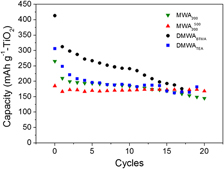Crossref Citations
This article has been cited by the following publications. This list is generated based on data provided by
Crossref.
Zeng, Muling
Laromaine, Anna
Feng, Wenqian
Levkin, Pavel A.
and
Roig, Anna
2014.
Origami magnetic cellulose: controlled magnetic fraction and patterning of flexible bacterial cellulose.
J. Mater. Chem. C,
Vol. 2,
Issue. 31,
p.
6312.
Carlucci, Claudia
Xu, Hua
Scremin, Barbara Federica
Giannini, Cinzia
Altamura, Davide
Carlino, Elvio
Videtta, Valeria
Conciauro, Francesca
Gigli, Giuseppe
and
Ciccarella, Giuseppe
2014.
Selective synthesis of TiO2 nanocrystals with morphology control with the microwave-solvothermal method.
CrystEngComm,
Vol. 16,
Issue. 9,
p.
1817.
Carlucci, Claudia
Scremin, Barbara
Sibillano, Teresa
Giannini, Cinzia
Filippo, Emanuela
Perulli, Patrizia
Capodilupo, Agostina
Corrente, Giuseppina
and
Ciccarella, Giuseppe
2014.
Microwave-Assisted Synthesis of Boron-Modified TiO2 Nanocrystals.
Inorganics,
Vol. 2,
Issue. 2,
p.
264.
Filippo, Emanuela
Carlucci, Claudia
Capodilupo, Agostina Lina
Perulli, Patrizia
Conciauro, Francesca
Corrente, Giuseppina Anna
Gigli, Giuseppe
and
Ciccarella, Giuseppe
2015.
Enhanced Photocatalytic Activity of Pure Anatase Tio2 and Pt-Tio2 Nanoparticles Synthesized by Green Microwave Assisted Route.
Materials Research,
Vol. 18,
Issue. 3,
p.
473.
Pratheep, P.
Vijayakumar, E.
and
Subramania, A.
2015.
Polyol thermolysis synthesis of TiO2 nanoparticles and its paste formulation to fabricate photoanode for dye-sensitized solar cells.
Applied Physics A,
Vol. 119,
Issue. 2,
p.
497.
Albetran, Hani
and
Low, It Meng
2016.
Effect of indium ion implantation on crystallization kinetics and phase transformation of anodized titania nanotubes using in-situ high-temperature radiation diffraction.
Journal of Materials Research,
Vol. 31,
Issue. 11,
p.
1588.
Blanc, Lauren E.
Sun, Xiaoqi
Shyamsunder, Abhinandan
Duffort, Victor
and
Nazar, Linda F.
2020.
Direct Nano‐Synthesis Methods Notably Benefit Mg‐Battery Cathode Performance.
Small Methods,
Vol. 4,
Issue. 5,
Poppi, Giulia
Colombini, Elena
Salvatori, Diego
Balestri, Alessio
Baldi, Giovanni
Leonelli, Cristina
and
Veronesi, Paolo
2022.
A Multi-Physic Modelling Insight into the Differences between Microwave and Conventional Heating for the Synthesis of TiO2 Nanoparticles.
Processes,
Vol. 10,
Issue. 4,
p.
697.
Zhang, Qin
Hu, Yaobo
Wang, Jun
and
Pan, Fusheng
2023.
Low-temperatures synthesis of CuS nanospheres as cathode material for magnesium second batteries.
Journal of Magnesium and Alloys,
Vol. 11,
Issue. 1,
p.
192.
Salim, Evan T.
Saimon, Jehan A.
Muhsin, Maryam S.
Fakhri, Makram A.
Amin, Mustafa Hadi
Ibrahim, Raed Khalid
and
Qaeed, Motahher A.
2024.
Synthesis of WO3 NPs by pulsed laser ablation: Effect of laser wavelength.
Journal of Materials Science: Materials in Electronics,
Vol. 35,
Issue. 7,
